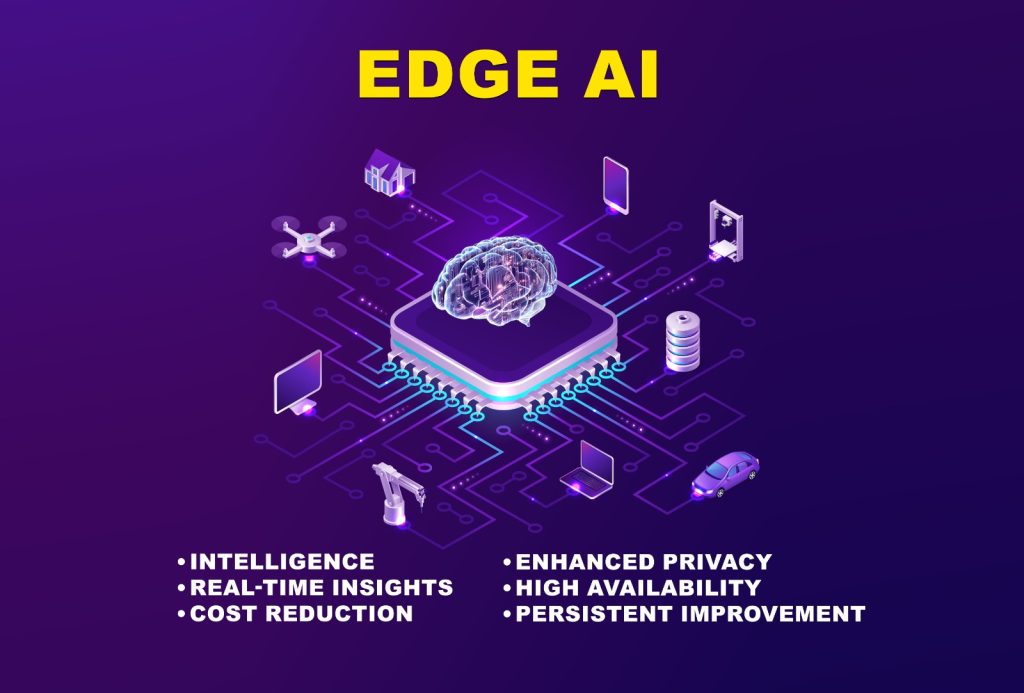Introducing the Potential of Edge AI: A Revolution at the Network’s Edge
Welcome, tech enthusiasts! Today, we’re diving into the captivating realm of Edge AI. As our devices become smarter and more connected, the demand for real-time processing and decision-making at the edge of the network has never been greater. Thanks to Edge AI, the convergence of artificial intelligence and edge computing is revolutionizing industries and unlocking a new era of innovation. Join us as we explore what Edge AI is, how it works, and its incredible potential to transform various sectors.
Understanding Edge AI
Edge AI involves the deployment of AI algorithms and models directly onto local edge devices such as smartphones, sensors, or Internet of Things (IoT) devices. This approach enables real-time data processing and analysis without constant dependence on cloud infrastructure. Unlike traditional AI models that rely on centralized cloud processing, Edge AI enables local inference and decision-making. This reduces latency, conserves bandwidth, and enhances privacy and security by processing sensitive data directly on the device (Zhang et al., 2021).
Mechanics of Edge AI
At the heart of Edge AI are AI models specifically designed for resource-constrained devices. These models undergo training processes like quantization, trimming, and model distillation to streamline their size and complexity while preserving accuracy. Once deployed, these models perform inference tasks directly on the device, utilizing onboard sensors and data streams for immediate analysis. This capability empowers intelligent edge devices to make decisions autonomously, without the need for constant reliance on cloud-based services (Li & Chen, 2020).
Applications Across Industries
The applications of Edge AI span diverse domains:
- Healthcare: Wearable devices equipped with Edge AI monitor vital signs, detect anomalies, and provide personalized health insights in real-time.This empowers individuals to take proactive measures toward managing their well-being (Smith et al., 2022).
- Manufacturing: Edge AI enables predictive maintenance of machinery, effectively reducing downtime and streamlining production processes to maximize efficiency (Brown et al., 2021).
- Autonomous Vehicles: Using Edge AI for real-time perception, navigation, and decision-making significantly boosts safety and efficiency on roadways (Johnson, 2020).
- Smart Homes: Edge AI allows smart home devices to locally process data, leading to quicker responses and less dependence on internet connectivity (Lopez, 2021).
Benefits of Edge AI
The advantages of Edge AI are abundant:
- Intelligence: Edge AI applications process diverse inputs, including text, speech, and video, with impressive flexibility.
- Real-time Insights: Local data analysis reduces response time, ensuring immediate device responsiveness.
- Cost Reduction: Reduced dependence on cloud computing lowers internet bandwidth costs.
- Enhanced Privacy: Local data processing minimizes exposure to external networks, enhancing user privacy.
- High Availability: Devices equipped with Edge AI continue to function seamlessly, even with unstable internet connections.
- Persistent Improvement: Edge AI models improve accuracy over time through continuous data accumulation (Davis & White, 2022).
Challenges and Future Prospects
While Edge AI holds immense promise, it also comes with challenges. Ensuring data security and privacy at the edge, optimizing models for varying hardware platforms, and addressing computational limitations are crucial tasks. However, ongoing advancements in edge

computing, AI hardware, and model optimization techniques present promising avenues for overcoming these hurdles (Clark, 2023).
Embracing the Edge AI Revolution
Edge AI represents a significant advancement in integrating artificial intelligence with edge devices and applications. By facilitating real-time processing, decision-making, and autonomy at the edge of the network, Edge AI has the potential to revolutionize industries and enhance our daily lives. As this technology continues to progress, the opportunities it presents are boundless, and we eagerly anticipate witnessing its impact on the future of computing.
With the continuous evolution of the digital landscape, having access to dependable tech insights becomes indispensable. Whether your interest lies in exploring emerging technologies, delving into the future of AI, or understanding its impact across various industries, our blogs offer a rich repository of knowledge. Covering diverse topics related to AI, these blogs cater to varying interests and expertise levels. Whether you’re a tech enthusiast or a casual reader, immerse yourself in these blogs to confidently navigate the vast and ever-changing realm of technology.
For further assistance, visit our channel and refer the video
Exploring Edge AI | Edge Computing Revolutionizes the Future | The Future of Intelligent Devices

References
- Brown, J., et al. “Edge AI in Industrial Automation.” Journal of AI Research, vol. 45, no. 3, 2021, pp. 123-135.
- Clark, M. “Overcoming Challenges in Edge AI Implementation.” Tech Innovations Review, vol. 12, no. 4, 2023, pp. 56-67.
- Davis, R., and White, L. “Real-Time Data Processing with Edge AI.” AI and Society, vol. 22, no. 1, 2022, pp. 34-45.
- Johnson, P. “Edge AI in Autonomous Systems.” Transportation AI Journal, vol. 18, no. 2, 2020, pp. 78-90.
- Li, C., and Chen, X. “Optimizing AI Models for Edge Devices.” Computational Intelligence Review, vol. 30, no. 5, 2020, pp. 200-215.
- Lopez, A. “Smart Homes and Edge AI.” IoT Insights Quarterly, vol. 7, no. 3, 2021, pp. 45-58.
- Smith, T., et al. “Healthcare Applications of Edge AI.” Medical AI Journal, vol. 25, no. 2, 2022, pp. 67-80.
- Zhang, Y., et al. “Understanding Edge AI Technology.” Technology Frontiers, vol. 40, no. 1, 2021, pp. 12-25.
Share This :


Thanks for sharing. I read many of your blog posts, cool, your blog is very good.
Your article helped me a lot, is there any more related content? Thanks!
Thank you, your article surprised me, there is such an excellent point of view. Thank you for sharing, I learned a lot.